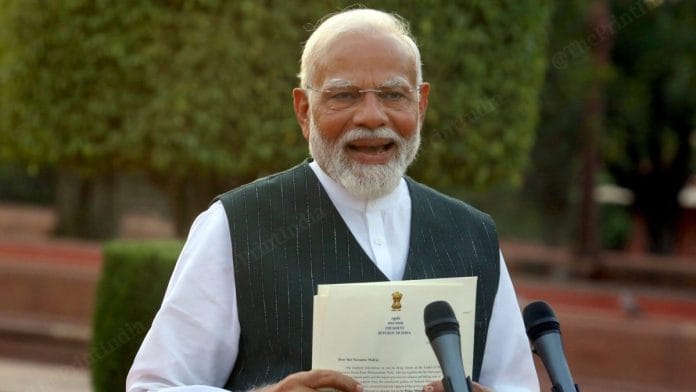New Delhi: Prime Minister Narendra Modi seeks to re-energise ties with key foreign investment (FDI) contributor Singapore and oil-rich Brunei as he embarks on a visit to these ASEAN countries Tuesday.
The upcoming tour, experts said, marks a push by New Delhi to affirm its commitment to Southeast Asia, notwithstanding its ties with China.
In Singapore, Modi will meet new Prime Minister Lawrence Wong, Indian-origin President Tharman Shanmugaratnam and senior minister Lee Hsien Loong, who recently stepped down as the country’s PM.
Modi will also participate in a business roundtable with Singaporean industrialists, interact with the country’s semiconductor players, and with students who have interned in India.
A series of MoUs are also expected to be signed during the visit in converging areas of interest like food security, digitisation, skilling, health, advanced manufacturing and connectivity. It is unclear if a joint working group on defence, which is currently pending, will be established during the visit.
Singapore is India’s largest ASEAN trade partner and biggest source of FDI, which amounted to $11.77 billion in FY24.
Diplomatic sources, however, said the elevation of ties to the level of a comprehensive strategic partnership was “unlikely” during the visit. India and Singapore last promoted relations to a strategic partnership in 2015.
Last week, a high-level delegation of Indian ministers visited Singapore for the second India-Singapore Ministerial Roundtable (ISMR). Among them were External Affairs Minister S. Jaishankar, Finance Minister Nirmala Sitharaman, Commerce and Industry Minister Piyush Goyal and Electronics and Information Technology, Railways, Information and Broadcasting Minister Ashwini Vaishnaw.
This set the stage for Modi’s upcoming visit this week, who last visited the country in 2018.
Modi and his Singapore counterpart are likely to discuss the ASEAN-India Free Trade Agreement (FTA), maritime security and the situation in Myanmar, said Jaideep Mazumdar, Secretary (East), Ministry of External Affairs, at a press briefing Monday.
Amitendu Palit, Senior Research Fellow in the Institute of South Asian Studies (ISAS) at the National University of Singapore (NUS), said the visit may also seek to give more heft to the Indo-Pacific Economic Framework for Prosperity (IPEF), which India, Singapore and Brunei are a part of.
“This may be seen as part of India’s efforts to play a proactive role in the Indo-Pacific, including in the IPEF. Brunei and Singapore, along with India are part of IPEF. This could also be seen as enhancing the China+1 outreach given growing geoeconomic necessity to maintain resilient supply chains,” Palit told ThePrint.
With Brunei, India will be seeking further gas and space cooperation, as Modi becomes the first-ever Indian PM to visit the country.
Brunei, ruled by Sultan Hassanal Bolkiah, is strategically located at the heart of Southeast Asia on key maritime trade routes, which makes it a critical partner for connectivity projects in the region.
Also read: India-Japan 2+2: What Jaishankar, Rajnath focused on during 3rd edition of bilateral dialogue
‘Resurrection of interest’
Singapore-based political scientist Kanti Bajpai said the visit marked a “resurrection” of interest in Singapore’s government towards India.
“Singapore is thinking of India seriously once again after a lull over the last 4-5 years. This lull was marked by Covid-19, the shutting down of the Amaravati capital city startup project in Andhra Pradesh, India’s decision to pull out of RCEP which was disappointing to Singapore, among other factors,” Bajpai told ThePrint.
In November 2019, the then newly-elected Andhra Pradesh government led by Y.S. Jagan Mohan Reddy closed down the Amaravati Capital City Start-Up Area project which had been the brainchild of now CM Chandrababu Naidu, during his previous term as chief minister. Two years earlier, Naidu and the Singapore government formed a joint company to develop the 6.84 square-km project. The Singapore consortium was slated to hold 58 percent stake.
This was the same year that India announced it would not be joining the Regional Comprehensive Economic Partnership (RCEP).
Wong’s stance on China and its actions in the South China Sea are yet to be seen. In an interview with The Economist in May, he was asked about the US-China rivalry in the Indo-Pacific and said Singapore was neither “pro-China nor pro-America”.
Kanti Bajpai further said the Indian side would want to engage with Wong who has tread a completely different career trajectory than his predecessor. “Wong is seen as a centrist or left of centre. Despite Singapore being a free market, he has introduced a wave of reforms and policies aimed at the welfare of the common man. He’s not part of the elite and comes from relatively humble beginnings,” he said.
At a briefing Monday, the MEA secretary said that with the new leadership in Singapore, this would be an “opportune time” to set up bilateral relations for the next stage.
On maritime security, the MEA secretary said it would be important for Singapore to maintain sea lines that are “safe” and secure, and that New Delhi and the Singaporean side have a “convergence of views” on that issue.
Recent clashes between China and the Philippines in the South China Sea have caught the attention of several regional players. Beijing has maritime and territorial disputes with over 15 neighbours.
(Edited by Tikli Basu)
Also read: Modi’s Ukraine visit sends many signals. Some seem aimed for Russia







When we say China+1, the 1 could be either us or the ASEAN countries. If we really wish to derisk from China, we must stop looking at these countries as competitors & shall look for friendshoring certain supply chains. Our pull back from RCEP, renegotiating ASEAN FTA as well as reluctance to sign up certain pillars of the IPEF signals closing up of our economy.